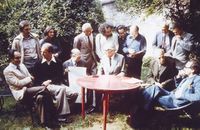User:Stonestone/6OULIPO: Difference between revisions
Stonestone (talk | contribs) |
Stonestone (talk | contribs) No edit summary |
||
| (5 intermediate revisions by the same user not shown) | |||
| Line 14: | Line 14: | ||
Only a machine can appreciate a sonnet written by another machine.-- Turing </blockquote> | Only a machine can appreciate a sonnet written by another machine.-- Turing </blockquote> | ||
*<em>Yours for the Telling -- Reymond Queneau<em><br /> | *<em>Yours for the Telling -- Reymond Queneau<em><br />[[File:OLP2.JPG|200px|thumb|right|Yours for the Telling]] | ||
[[File:OLP2.JPG|200px|thumb|right|Yours for the Telling]] | |||
*<em>A Brief History of the Oulipo -- Jean Lescure</em><br /> | *<em>A Brief History of the Oulipo -- Jean Lescure</em><br /> | ||
| Line 23: | Line 23: | ||
*<em>Prose and Anticombinatorics -- Italo Calvino</em><br /> | *<em>Prose and Anticombinatorics -- Italo Calvino</em><br /> | ||
<hr /> | <hr /> | ||
===Relationship with The World of Art in the Age of Digital Recombination=== | ===Relationship with The World of Art in the Age of Digital Recombination=== | ||
*Oulipo is in the gap of Exhibition Value and Manipulation Value. | *Oulipo is in the gap of Exhibition Value and Manipulation Value. | ||
*Oulipo can be treated as a database. | *Oulipo can be treated as a database. | ||
*The writers are the organisers of the databases(letters, words, sentence), the readers are the real writers. | *The writers are the organisers of the databases(letters, words, sentence), the readers are the real writers. | ||
<hr /> | |||
== - - - - > Presentation<br />== | |||
<strong>Six Selections By The Oulipo</strong><br /> | |||
Oulipo (workshop of potential literature) is a loose gathering of (mainly) French-speaking writers and mathematicians who seek to create works using constrained writing techniques. It was founded in 1960 by Raymond Queneau and François Le Lionnais. <br /> | |||
The group defines the term potential literature as: "the seeking of new structures and patterns which may be used by writers in any way they enjoy." Constraints are used as a means of triggering ideas and inspiration, most notably Perec's "story-making machine", which he used in the construction of Life A User's Manual. As well as established techniques,often based on mathematical problems, such as the knight's tour of the chess-board and permutations. people focus more on communication content than on its way.<br /> | |||
The works of oulipo is more like a linguistic game. For instance, One Hundred Thousand Billion Poems and Yours for the Telling -- Reymond Queneau are more like a matching games, and the novel Disparition which is written by Georges Perec, there is no letter ”e” which is quite common and important in French. I think the art works from the Oulipo focus on the sense of writing form much more than content. When the novel Disparition just came out, people was shocked very much, however, years later, the Perec wrote another novel in the similiar way, �the readers just became tired of it. So I do not think Oulipo is something full of mistery, the writers just wanted to find a new way of literature by making writing rules and finding strategies. <br /> | |||
From my perspective, and oulipo can be treated as a software, the writers are more like the organisers or programmers of the databases of software(letters, words, sentence), the readers are the real writers who do the remaching, creating and reunderstanding. <br /> | |||
*Oulipo is in the gap of Exhibition Value and Manipulation Value. | |||
Latest revision as of 11:29, 14 October 2015
Six Selections By The Oulipo
What is Oulipo
Oulipo(workshop of potential literature) is a loose gathering of (mainly) French-speaking writers and mathematicians who seek to create works using constrained writing techniques. It was founded in 1960 by Raymond Queneau and François Le Lionnais. Other notable members have included novelists Georges Perec and Italo Calvino, poets Oskar Pastior, Jean Lescure and poet/mathematician Jacques Roubaud.
The group defines the term littérature potentielle as: "the seeking of new structures and patterns which may be used by writers in any way they enjoy." Constraints are used as a means of triggering ideas and inspiration, most notably Perec's "story-making machine", which he used in the construction of Life A User's Manual. As well as established techniques, such as lipograms (Perec's novel A Void) and palindromes, the group devises new methods, often based on mathematical problems, such as the knight's tour of the chess-board and permutations.
--Wikipedia
This Book
- One Hundred Thousand Billion Poems -- Reymond Queneau
Raymond Queneau’s A Hundred Thousand Billion Poems or One hundred million million poems, published in 1961, is a set of ten sonnets. They are printed on card with each line on a separated strip, like a heads-bodies-and-legs book, a type of children's book with which Queneau was familiar. As all ten sonnets have not just the same rhyme scheme but the same rhyme sounds, any lines from a sonnet can be combined with any from the nine others, so that there are 100,000,000,000,000 different poems.-- Wikipedia
Only a machine can appreciate a sonnet written by another machine.-- Turing
- Yours for the Telling -- Reymond Queneau
- A Brief History of the Oulipo -- Jean Lescure
- For a Potenteial Analysis of Combinatory Literature -- Claude Berge
- Computer and Writer: The Centre Pompidou Experiment -- Paul Fournel
- Prose and Anticombinatorics -- Italo Calvino
Relationship with The World of Art in the Age of Digital Recombination
- Oulipo is in the gap of Exhibition Value and Manipulation Value.
- Oulipo can be treated as a database.
- The writers are the organisers of the databases(letters, words, sentence), the readers are the real writers.
- - - - > Presentation
Six Selections By The Oulipo
Oulipo (workshop of potential literature) is a loose gathering of (mainly) French-speaking writers and mathematicians who seek to create works using constrained writing techniques. It was founded in 1960 by Raymond Queneau and François Le Lionnais.
The group defines the term potential literature as: "the seeking of new structures and patterns which may be used by writers in any way they enjoy." Constraints are used as a means of triggering ideas and inspiration, most notably Perec's "story-making machine", which he used in the construction of Life A User's Manual. As well as established techniques,often based on mathematical problems, such as the knight's tour of the chess-board and permutations. people focus more on communication content than on its way.
The works of oulipo is more like a linguistic game. For instance, One Hundred Thousand Billion Poems and Yours for the Telling -- Reymond Queneau are more like a matching games, and the novel Disparition which is written by Georges Perec, there is no letter ”e” which is quite common and important in French. I think the art works from the Oulipo focus on the sense of writing form much more than content. When the novel Disparition just came out, people was shocked very much, however, years later, the Perec wrote another novel in the similiar way, �the readers just became tired of it. So I do not think Oulipo is something full of mistery, the writers just wanted to find a new way of literature by making writing rules and finding strategies.
From my perspective, and oulipo can be treated as a software, the writers are more like the organisers or programmers of the databases of software(letters, words, sentence), the readers are the real writers who do the remaching, creating and reunderstanding.
- Oulipo is in the gap of Exhibition Value and Manipulation Value.


